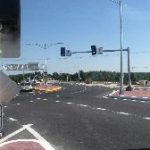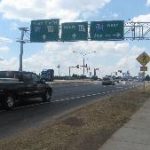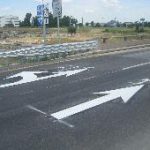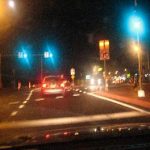FAQ
When should a DDI be considered?
A DDI should be considered for any interchange where signal lights can be expected on the cross road. The DDI works best if one of the left turning movements is high and/or if thru movements are unbalanced during peak hours. The DDI can solve many other issues such as queuing, synchronization, bottlenecks, lane balancing, weaving, pedestrians, special event needs, and widening needs.
Will the DDI only work in certain climates?
This question usually refers to weather maintenance issues such as snow plowing. Snow plowing is very easy with this design since it is essentially two one-way roads through the interchange. The design has islands where the ramps meet the cross road, where snow can be placed.
Is there a difference if the highway goes over or under the cross road?
Not really. Proper sight distance considerations should be given for the right turns from the ramps if there is a structure in the way. This is no different from any other interchange design consideration.
How will the DDI function during a power outage?
The DDI should function without any confusion. The geometry will guide drivers to the correct location with the only difference being that there will be a full stop condition at the crossovers instead of a signal control. This is one of the advantages of the DDI over the single point urban interchange (SPUI) or a continuous flow interchange (CFI).
Will the DDI cause driver confusion?
If designed properly, the DDI should not cause any driver confusion. Elements such as geometric curves, signing, and lane markings must be designed properly. Based on the experience of the new DDI in Springfield, Missouri, the DDIs in France and FHWA’s driver simulations, there seem to be very little driver confusion.
How should the DDI be signed and striped?
There are two unconventional elements that need to be addressed through proper signing and striping. The first is the crossover movements. Lane markings should go through the crossovers with thru arrows preferred both before and after the intersection per the 2009 Manual of Uniform Traffic Control Devices (MUTCD). The thru intersection lane control signs should be placed next to the signal heads for added guidance. The second unconventional element is having a shared left lane for thru and left turns. Guidance should be given on the approach to the interchange as to which lane is appropriate for each movement. An additional intersection lane control sign should be placed prior to the left turning movement along with the appropriate arrow markings on the pavement. The lane control sign must be placed in a proper location so that drivers won’t see it at the crossover.
Are there headlight concerns, since traffic is directly in front of each other before the crossovers?
No. The direct headlight approach is a farther distance than a common scenario where a left turn lane is directly opposite the opposing left turn. The headlights do not affect the crossover movements since vehicles are angled away from each other at the crossovers. Putting up any type of headlight shields (also known as glare screens) on the curb is ill-advised since there will be cause a safety issue due to poor sight distance.
How are pedestrians and cyclists treated in the DDI?
There are different options. Pedestrians can be treated in the median between the crossovers or along the side of the road. Each has its advantages and disadvantages. Cyclists that have a bike lane adjacent to the right lane can cross over with vehicular traffic. They could also use a dedicated median bike lane with some lane marking guidance.
What should the crossover angle be? [Updated Answer]
AASHTO states that an intersection should be as close to a 90 degree angle as possible. However, the reasoning behind this is mainly due to turning movements. In the DDI, there are no turning movements at the crossover. Therefore the only concern should be to have enough of an angle to avoid wrong way movements that could lead to a head-on collision. The best way to prevent head on collisions is to not have a direct path from any travel lane from the one approach into the approach in the opposite direction at the crossover. If constraints prevent this from being possible, there should at least be an effort to avoid a direct path on the outside lanes into the opposing traffic.
Should the ramp turning movements be signalized?
It depends on several factors such as sight distance, traffic volumes, and queuing concerns. If for some reason, the geometry does not give good guidance for left turns from the ramp, a signal is advisable. The DDI should be evaluated using simulations with and without ramp movement signalization if safety is not a concern.
How does the DDI affect adjacent intersections?
The progression of traffic changes with a DDI since the DDI acts essentially as a split-phased signal. This may allow other signalized intersections to be placed closer to the interchange than is typical. More information on this topic can be seen in Chlewicki’s paper Operational Effects of the Diverging Diamond Interchange that was presented at the 2010 Annual TRB Meeting in Washington, DC.
How will/does the public react to the DDI?
If presented properly, the public is generally receptive to the design once they fully understand it. It looks confusing to them when they see the DDI from plan view. However, the public is generally impressed after they see the design in action and they get all the proper information of the operations, safety, and costs. There will always be a few that are opposed to anything new, but that should change once more successful DDIs are built.
How do you accurately compare the DDI to other interchange forms
Most papers thus far have compared the DDI to other diamond interchange forms with the same amount of thru lanes. The DDI is very competitive with this comparison. If the DDI is compared based on the amount of lanes over or under the bridge, the DDI is the superior design on most occasions. In practical terms, a cost-benefit analysis is the best comparison. The DDI can compare favorably to cloverleaf forms as well when the comparison is based on the same amount of lanes that would be needed over or under the bridge.
Should the first DDI in an area be placed where a high percentage of non-locals will be driving?
The thinking here is that the more familiar drivers are with the DDI configuration, the better traffic will flow through the interchange. The opposite argument could be made that if a lot of new drivers go through the interchange, they will be more attentive since they are in an unfamiliar area and need to be more alert. The most important element of the first DDI in an area is that it needs to be a success. So if it is well designed and constructed, it will not matter where it is placed.
Is a DDI better in an urban or rural setting?
The DDI can be placed in any setting. A DDI in a rural area may have the advantage of different signal progression options. A DDI in an urban area has the advantage of being able to fit in a tight area. The traffic volumes usually guide the consideration for the DDI no matter what setting it is in.





